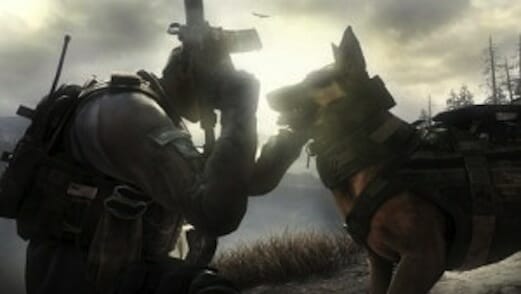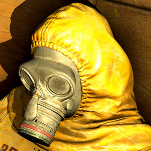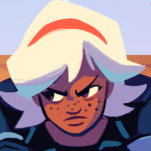Call of Duty: Ghosts (Multi-Platform)

Suppose a billionaire luthier (already implausible) gives you a mythically well-crafted electric guitar but restricts playing the guitar to three specific scenarios. First, you can play it by yourself, but the strings from frets five and up are replaced with colorful buttons, and it can only play a cover of “Danger Zone” by Kenny Loggins. You can play it as much as you want.
Second, you can play in a guitar quartet, but each member has to play one of four parts to Carol of the Bells by Trans-Siberian Orchestra. While you’re playing, the luthier will throw dead fish at you. You can play it as much as you want.
Last, because you’re not the only one fortunate enough to receive this eccentric billionaire’s charity, you can rock out in a jam session with friends and strangers to fourteen different songs (fifteen if you pay a little). Only now you can customize your guitar with pedals and amps, and you can choose to play with the others, at the others, against the others, to the others, or around the others before you explode. You can play it as much as you want.
The point of the analogy is to draw out the element that undergirds Call of Duty: Ghosts and has supported the series since Call of Duty 4: Modern Warfare: its instrument. Often this is referred to as the game’s mechanics, or more crudely, its gameplay. It’s the guitar, the core piece of tech required to participate in any of the three events. Without its unique timbre, shiny pickups, and silvery strings, it might be just another guitar. And only guitar players can recognize its voice and discern its sound from that of another guitar. To everyone else, it’s just another popular, high-quality axe.
The analogy also brings into view the tripartite structure of Ghosts, a design approach that started with Call of Duty: World at War and resurfaced as recently as last year’s Call of Duty: Black Ops 2. The underlying philosophy to this approach, I think, is that if someone doesn’t like hyper-linear, high-action target practice (single player campaign), then they could still buy the game for its manically rewarding online fracas (multiplayer) or the arcade-style cooperative survival mode (now called Extinction). The three distinct games packed into Ghosts are unified by the mechanical instrument that has brought the series this far: the fast-paced, clear presentation and execution of movement, shooting, and interaction.
So it’s worthwhile, I think, to discuss these components separately, starting with the guitar, the framework that the other three build on. Call of Duty: Ghosts is the seventh game in the Call of Duty series since the introduction of the gameplay that launched the franchise’s current trajectory, and the fourth installment made primarily by development studio Infinity Ward (the other four were made primarily by development studio Treyarch). To then call Ghosts a refining of a previous work would be not only precise but illuminating.
Let’s also not act like this game was developed in some alternate universe where Modern Warfare 3 didn’t gross $775 million on its release day two years ago and Blacks Ops 2 didn’t gross $800 million on its release day last year. It would be fiscally irresponsible, one might argue, for Call of Duty’s creators to not re-use this clearly successful formula in Ghosts as well. That Ghosts feels remarkably similar in its core gameplay design to past Call of Duty games, to say nothing of its three-part structure or narrative call-backs, should be both unsurprising and understandable. The temptation with critiquing this kind of development iteration (again, this is the seventh one of these games) is to demand something different, maybe even something more. I’d argue that Ghosts delivers precisely what it means to, almost exactly how it should. That I, and vocal others, have grown weary of this formula, is a reflection of the intersection of game and game culture.
With that in mind, I can say with a clean conscience that Ghosts’ mechanical play design is superb, maybe the best in the industry. Running at 60 frames-per-second across all console platforms (according to Infinity Ward, and in my experience on the Xbox 360 version), the mania of activity in a firefight still stuns me, and the wickedly responsive controls allow me to dive into the character’s perspective. For instance, because I don’t see a lag in the frame rate, and because I’m not held back by a sluggish run mechanic or heavy-feeling vaulting mechanic, I never feel like I’m controlling an avatar, but instead feel like I’m playing a role. It’s just a few inches of difference academically, and but it feels practically a world apart.
From inside this helmet, I turn to shoot, and Infinity Ward’s impressive understanding of feedback loops comes into play. In forsaking realism for the sake of play, the developer implements a slight visual cue and tight zipping sound to signify when I’ve hit my mark, as has been done since the first Modern Warfare. Only in Ghosts, a dynamic sound system morphs the sounds from yours and other weapons based on the space they’re in, conveying spatial awareness for aesthetic and tactical use. Other mechanical additions like the knee-slide and contextual lean are the cherry on top of what is otherwise a familiar, effective system.
It’s a shame, then, that a studio with such a knack for fine-tuning its core competency does nothing remarkable with it in the single player campaign. There’s some overarching plot about an elite military group called the Ghosts, some bad 300-style cut scenes to connect the sinews of the narrative to the shooting, and there’s a lot of rooms with shooting. Or buttons. Or more shooting. Or explosions. Or invincible vehicle segments. The point is that even though the levels have the veneer of variety, they lack any real skill challenge outside of the stop-and-pop shooting bits, which I still find genuinely fun if somewhat bedraggled.
-

-

-

-

-

-

-

-

-

-

-

-

-

-

-

-

-

-

-

-

-

-

-

-

-

-

-

-

-

-

-

-

-

-

-

-

-

-

-

-










































